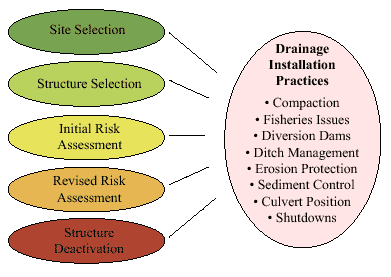| Forest Road Drainage Installation Practices | |
| in the Pacific Northwest | |
| 1 - Introduction | Issues, Objectives, Additional References |

Sound drainage structure installation practices are essential to ensure the protection of environmental values and financial investments at stream crossings. It is important to foresee limiting factors during the installation as they can influence site selection and structure design for stream crossings. In fact, the entire life cycle of a drainage structure from site selection to deactivation is very much influenced by physical limitations during the installation process.
This Field Guide on drainage installation is meant to assist layout personnel in the selection of appropriate sites and types of drainage structures, and guide construction supervisors and machine operators to make sound decisions during structure installations. Furthermore, the risk assessment procedure provides a useful tool to prepare for many unexpected situations. Structure sizing, bridge design, and detailed design of "out of the ordinary" structures are not part of this Field Guide and commonly involve professional input.
This Field Guide is provided for technical guidance only. It does not replace the Forest Practices Code of BC Act (FPC) and other applicable laws, or the need for professional advice or design for stream crossings that do not represent everyday situations. Users of the information in this Field Guide must be familiar with relevant regulations and requirements in their jurisdiction. Although this presentation has been edited by individuals from the Ministry of Forests (Coast and Interior), Department of Fisheries and Oceans, and many professionals in the field, the writer does not assume any liabilities resulting from the use of this Field Guide. The efforts and suggestions of all editors have been invaluable and are very much appreciated.
1 - Introduction |
| Next |
||
|
PLANNING ISSUES
Introduction 1
|
INSTALLATION PRACTICES |
|
©1999 - 2001 Flip Productions Limited Used with permission by CulvertBC |